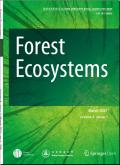气候生境调节两种针叶树径向生长对气候变化的敏感性
IF 3.8
1区 农林科学
Q1 FORESTRY
引用次数: 0
摘要
针叶树在气候变化,特别是干旱胁迫下的生存和死亡受到了广泛关注。然而,在不同的气候环境下,探讨同一针叶树种的生长动态对气候变化的响应至关重要。本研究旨在量化针叶树径向生长过程的变化,分析不同气候生境下针叶树在干旱期的恢复能力,并评估气候适应对针叶树生长的影响。本研究以青藏高原东北部两种针叶树种云杉(Picea crassifolia)和油松(Pinus tabuliformis)为研究对象,这两种树种分别分布在湿润生境和干燥生境。在干旱胁迫下,利用vs -示波器模型模拟了温度和湿度对两种树种生长的影响。云杉的生长在不同的气候生境之间表现出显著的差异。在干旱生境中,云杉的生长率随干旱而下降(- 0.91 cm2 / 10年,p <;0.01)。相比之下,松树的生长保持相对稳定(湿润生境:−0.03 cm2 / 10年;干燥生境:每十年0.25平方厘米,p >;0.01),但在生长季节仍对胁迫有反应(p <;0.05)。在干旱环境下,云杉的抗逆性降低(- 30.11%),而松木的抗逆性提高(+39.62%)。该物种的气候适应策略与温度和湿度对其生长速度的贡献有关。当温度相关的生长在生长季节表现出“双峰”模式时,湿度对干燥栖息地的两种针叶树的生长恢复至关重要。这些发现对于理解全球气候变化背景下的针叶林过程具有重要的生态学意义。本文章由计算机程序翻译,如有差异,请以英文原文为准。

Climatic habitat regulates the radial growth sensitivity of two conifers in response to climate change
The survival and mortality of conifer trees in response to climate change, particularly drought stress, have received considerable attention. However, it is crucial to explore the growth dynamics of the same conifer species in response to climate change in different climatic habitats. In this study, we aimed to quantify variations in the radial growth processes of conifer species, analyze their resilience during drought periods under different climatic habitats, and assess the impact of climate adaptation on conifer growth. We focused on two conifer species, Picea crassifolia (spruce) and Pinus tabuliformis (pine), which are distributed in both a humid habitat and a dry habitat in the northeastern Tibetan Plateau. Growth and resilience dynamics were identified across both climatic habitats and the contributions of temperature and moisture to the growth of the two species were simulated under drought stress using the VS-oscilloscope model. Spruce growth exhibited significant variability between climatic habitats. Specifically, the spruce growth rate declined in response to drought in the dry habitat (−0.91 cm2 per decade, p < 0.01). In contrast, pine growth remained relatively stable (humid habitat: −0.03 cm2 per decade; dry habitat: 0.25 cm2 per decade, p > 0.01), although it still responded to stress during the growing season (p < 0.05). Furthermore, spruce displayed reduced resistance during stress in dry habitats (−30.11%), while pine exhibited an enhanced recovery of growth rates to ensure survival (+39.62%). The climate adaptation strategies of the species were linked to the contribution of temperature and moisture to their growth rates. Moisture is critical for the growth recovery of both conifers in dry habitats when temperature-associated growth displays a ‘bimodal’ pattern during the growing season. These findings have significant ecological implications for understanding conifer forest processes in the context of global climate change.
求助全文
通过发布文献求助,成功后即可免费获取论文全文。
去求助
来源期刊

Forest Ecosystems
Environmental Science-Nature and Landscape Conservation
CiteScore
7.10
自引率
4.90%
发文量
1115
审稿时长
22 days
期刊介绍:
Forest Ecosystems is an open access, peer-reviewed journal publishing scientific communications from any discipline that can provide interesting contributions about the structure and dynamics of "natural" and "domesticated" forest ecosystems, and their services to people. The journal welcomes innovative science as well as application oriented work that will enhance understanding of woody plant communities. Very specific studies are welcome if they are part of a thematic series that provides some holistic perspective that is of general interest.
 求助内容:
求助内容: 应助结果提醒方式:
应助结果提醒方式:


